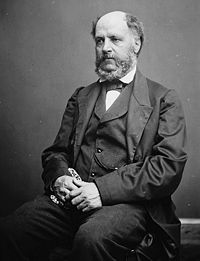Charles Benedict Calvert
| Charles Benedict Calvert | |
|---|---|
 |
|
| Member of the U.S. House of Representatives from Maryland's 6th district |
|
|
In office March 4, 1861 – March 3, 1863 |
|
| Preceded by | George Wurtz Hughes |
| Succeeded by | District abolished |
| Member of the Maryland House of Delegates | |
|
In office 1839–1846 |
|
| Personal details | |
| Born |
August 23, 1808 Riversdale, Maryland, U.S. |
| Died | May 12, 1864 (aged 55) Riverdale Park, Maryland, U.S. |
| Political party |
Democratic (1839–1860) Unionist (1861–1863) |
| Spouse(s) | Charlotte Augusta Norris (m. 1839; his death 1864) |
| Children | 6 children |
| Alma mater | University of Virginia |
| Profession | Businessman, landowner |
| Religion | Episcopalian |
Charles Benedict Calvert (August 23, 1808 – May 12, 1864) was an American politician who was a U.S. Representative from the sixth district of Maryland, serving one term from 1861–1863. He was an early backer of the inventors of the telegraph, and in 1856 he founded the Maryland Agricultural College, the first agricultural research college in America, now known as the University of Maryland. He was a direct descendant of the Lords Baltimore, proprietary governors of the Province of Maryland from 1631 until 1776.
Calvert was born on August 23, 1808 at his family's estate at Riversdale, Maryland. His mother was Rosalie Eugenia Stier (1778–1821), the daughter of a wealthy Belgian aristocrat, Baron Henri Joseph Stier (1743–1821) and his wife Marie Louise Peeters. The Stiers had fled to America in the early Nineteenth Century as Napoleon's armies occupied their home town of Antwerp. Calvert's father, the wealthy planter George Calvert (1768–1838), was the son of the Loyalist politician Benedict Swingate Calvert (c.1730–1788) - a natural son of the penultimate Proprietary Governor of Maryland, Charles Calvert, 5th Baron Baltimore - and his wife Elizabeth Calvert (1731 – 1788).
Calvert completed his preparatory studies at Bladensburg Academy of Maryland. Later, he received a certificate of completion from the University of Virginia at Charlottesville in 1827, even though he attended the university spuriously, and engaged in agricultural pursuits and stock breeding.
...
Wikipedia
